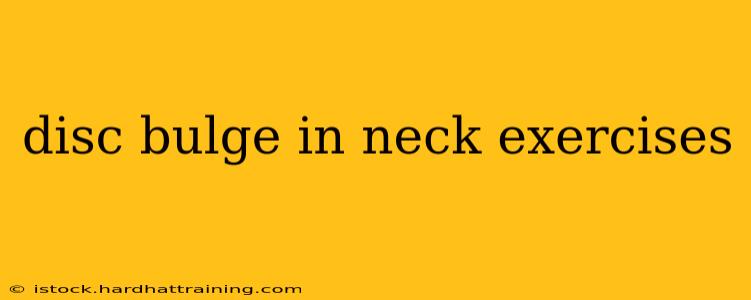A disc bulge in the neck, also known as cervical disc herniation, can cause significant pain, stiffness, and discomfort. While surgery is sometimes necessary, many individuals find relief through conservative treatments, including specific exercises. It's crucial to remember that these exercises are not a replacement for professional medical advice. Always consult your doctor or physical therapist before starting any new exercise program, especially if you have a neck injury. They can assess your specific condition and recommend the most appropriate exercises for your needs.
Understanding Cervical Disc Bulges
Before diving into exercises, let's briefly understand the condition. Intervertebral discs act as cushions between your neck vertebrae. A bulge occurs when the outer layer of a disc (annulus fibrosus) weakens, allowing the inner gel-like material (nucleus pulposus) to protrude. This can irritate nearby nerves, leading to pain radiating down the arm (radiculopathy), neck stiffness, headaches, and even numbness or tingling in the hands.
Gentle Exercises for Neck Disc Bulges
The goal of exercise is to strengthen supporting muscles, improve posture, and increase flexibility, all while avoiding movements that could exacerbate the bulge. Focus on gentle, controlled movements. Stop immediately if you experience increased pain.
1. Chin Tucks
This simple exercise strengthens deep neck flexor muscles that help stabilize the cervical spine.
- How to: Gently tuck your chin towards your chest, feeling a slight stretch under your chin. Hold for a few seconds, then return to the neutral position. Repeat 10-15 times.
- Focus: Avoid tilting your head or shrugging your shoulders. The movement should be subtle.
2. Neck Retractions
Similar to chin tucks, neck retractions further engage the deep neck muscles.
- How to: Gently pull your head backward, as if trying to create a double chin. Hold for a few seconds, and then return to the neutral position. Repeat 10-15 times.
- Focus: Keep your chin parallel to the floor. Avoid excessive backward movement.
3. Gentle Neck Rotations
This exercise improves range of motion and flexibility.
- How to: Slowly rotate your head to the right, holding for a few seconds. Then, slowly rotate to the left, again holding for a few seconds. Repeat 5-10 times in each direction.
- Focus: Keep the rotations gentle and controlled. Avoid forcing any movement.
4. Scapular Squeezes (Shoulder Blade Retractions)
Strengthening the muscles around your shoulder blades can indirectly support your neck.
- How to: Sit or stand tall. Squeeze your shoulder blades together, holding for a few seconds. Release and repeat 10-15 times.
- Focus: Imagine pinching a pencil between your shoulder blades.
5. Isometric Neck Holds
These exercises strengthen neck muscles without significant movement.
- How to: Gently press your head against your hand, resisting the pressure. Hold for 5-10 seconds. Repeat 5-10 times. You can do this with resistance in various directions (forward, backward, side to side).
- Focus: Maintain a relaxed posture while applying gentle pressure.
Important Considerations
- Listen to your body: If an exercise causes pain, stop immediately.
- Consistency is key: Perform these exercises regularly for optimal results. Consistency is more effective than intensity.
- Posture is crucial: Maintain good posture throughout the day to minimize strain on your neck.
- Ergonomics: Evaluate your workspace and adjust it to promote proper posture.
- Other therapies: Your doctor may recommend other therapies, such as physical therapy, medication, or injections, to manage your pain.
Disclaimer: This information is for general knowledge and does not constitute medical advice. Always consult with a healthcare professional before starting any exercise program, particularly if you have a pre-existing medical condition. They can provide personalized recommendations tailored to your specific needs and situation. They can also differentiate between a simple bulge and a more serious herniation. Early intervention is key to managing neck pain and preventing further complications.
